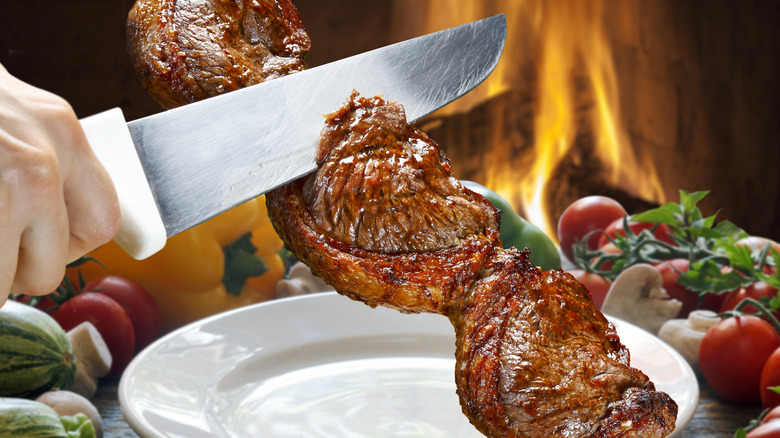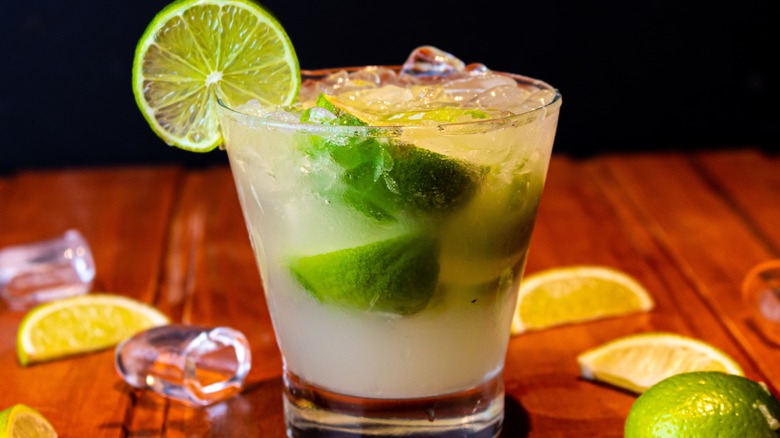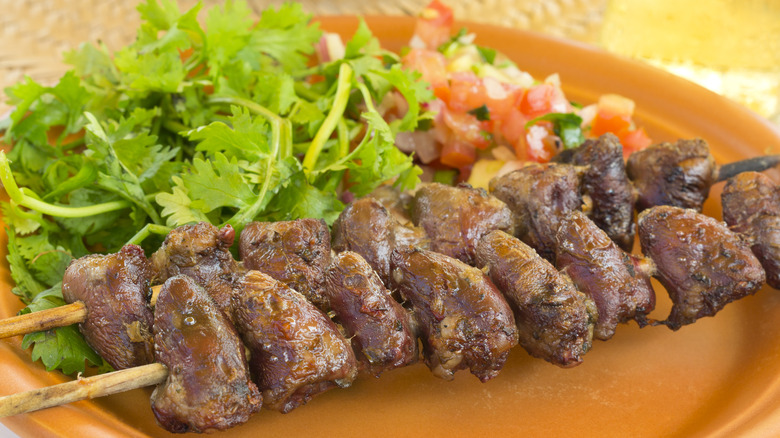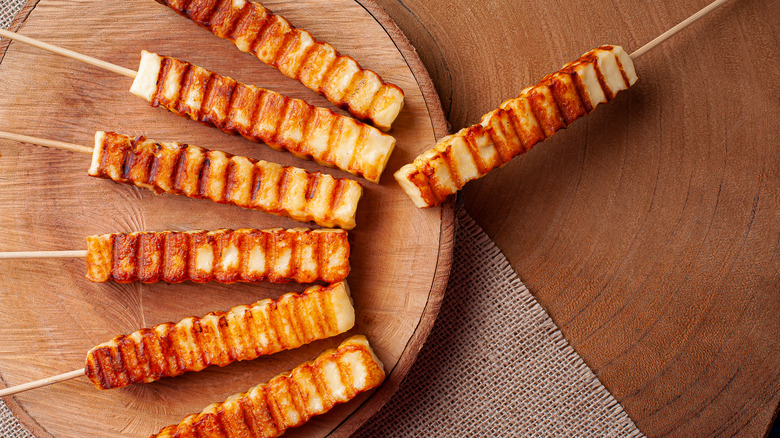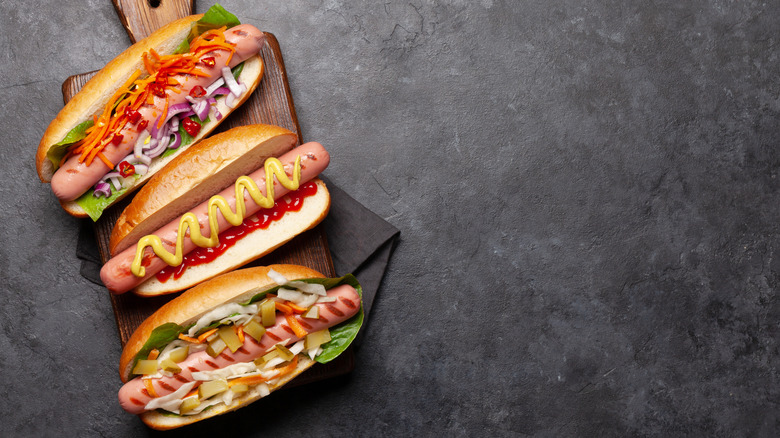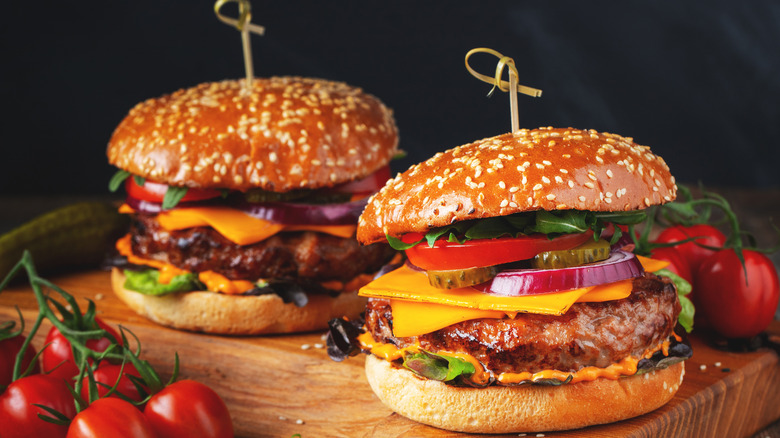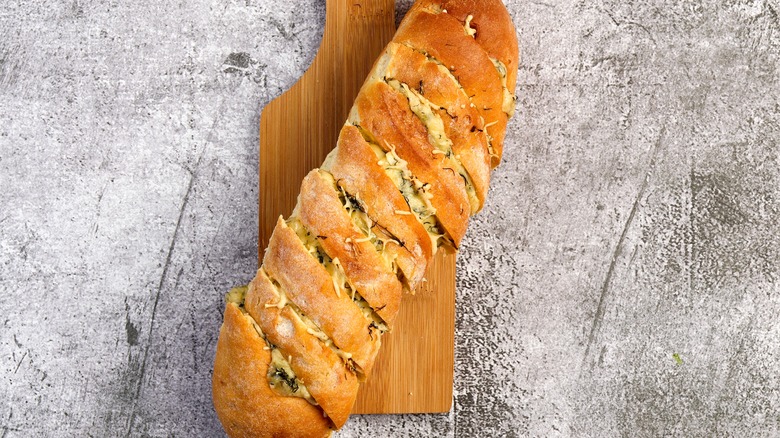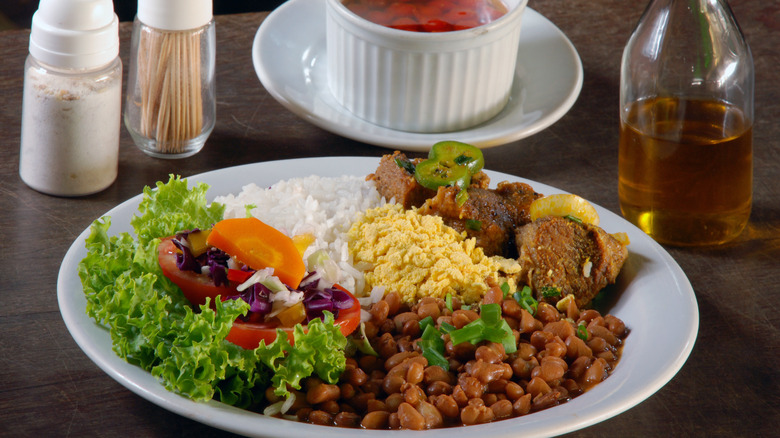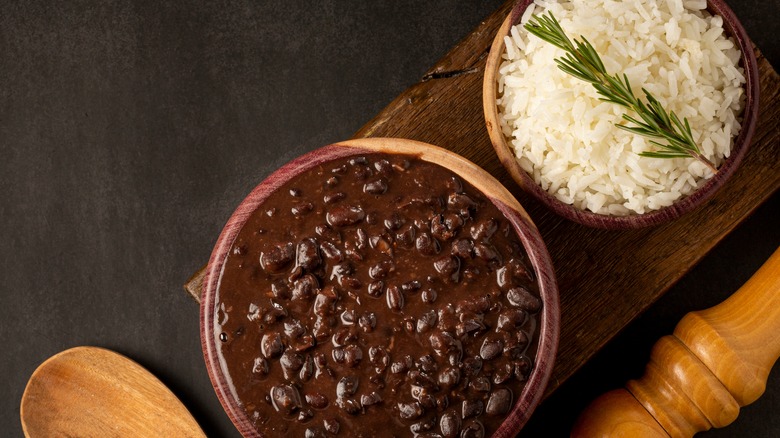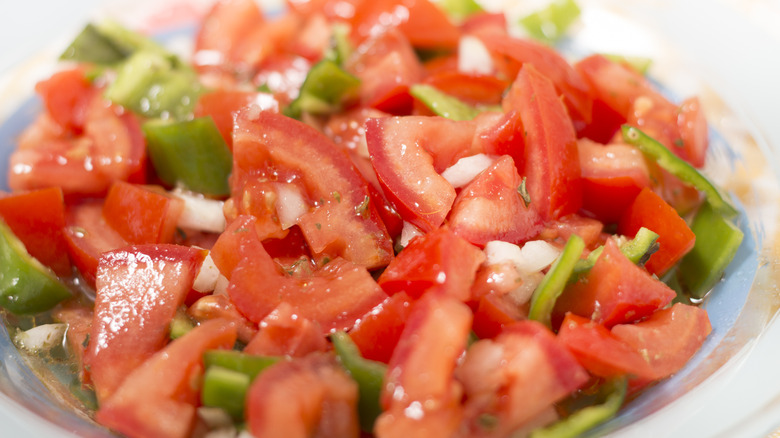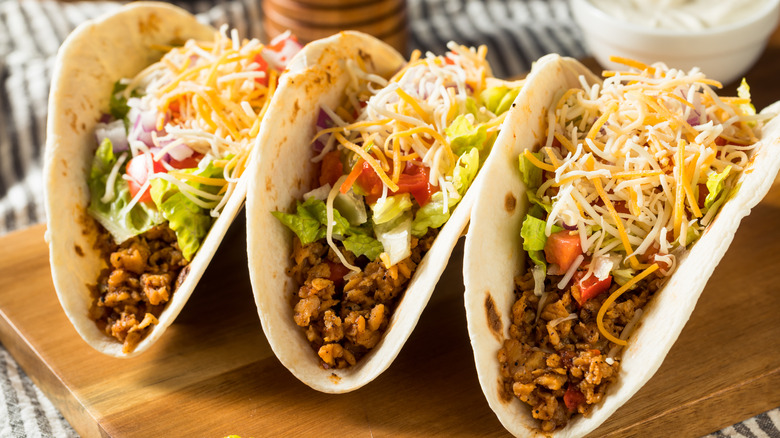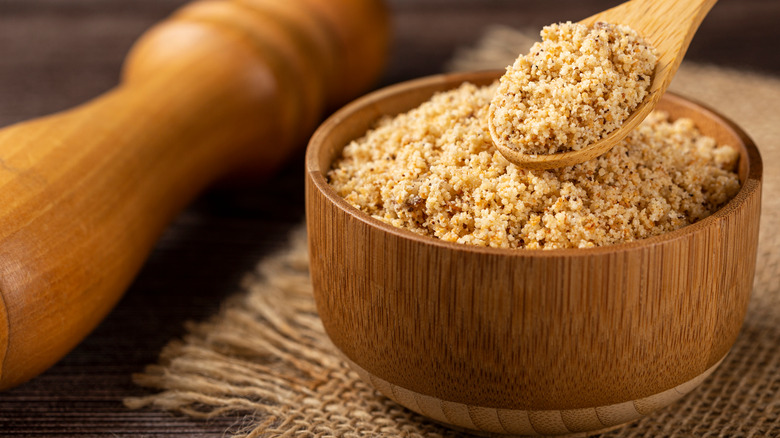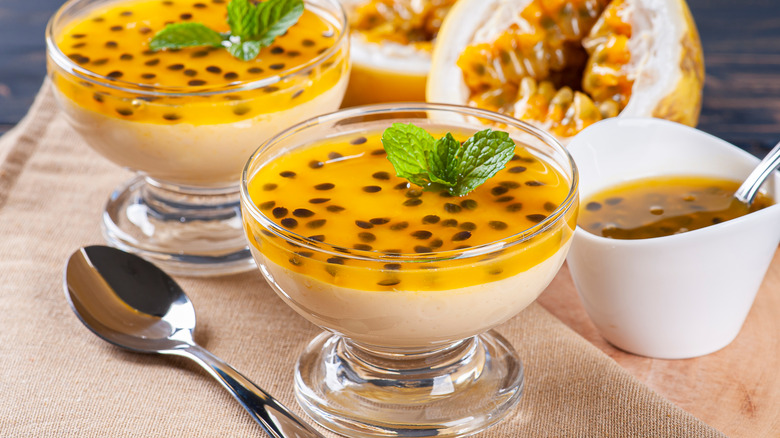13 Red Flags To Look Out For When Eating At A Brazilian Barbecue Restaurant
When it comes to sampling foods from around the world, American consumers are more interested in authenticity than you might imagine. According to the 2018 Ethnic Food & Beverage Consumer Trend Report (via Food Dive), consumers in the United States are invested in trying foods that cultures actually enjoy. In fact, 44% of Americans who eat foreign foods said that they always look for the most authentic international eats on the market. In practice, that means that folks are growing more interested in Mexican delicacies, like mole or pozole, than they are in American interpretations of these classics (think bright orange nacho cheese).
Of course, however, a huge part of selecting the most authentic international foods on the market is knowing how to differentiate the real stuff from cheesy Americanized interpretations. At Brazilian barbecue restaurants, also known as "churrascarias" in Portuguese, it isn't always easy for the untrained eye to determine whether or not the set-up is authentic. Luckily, though, there are plenty of tricks that can help you evaluate the quality of a churrascaria. From a lack of picanha to a failure to serve dessert, these red flags are solid indicators that a Brazilian barbecue restaurant is not authentic.
1. There is no picanha on the menu
Brazilian barbecue, or "churrasco," is, at its heart, a celebration of different cuts of meat and all the flavors they have to offer. Because of this, you can typically find dozens of different cuts of steak at a Brazilian churrascaria. Filet mignon is, of course, a favorite due to its tenderness. Meanwhile, maminha — a unique cut that includes a mix of bottom sirloin and the flank — is also a popular option due to its relatively lean yet succulent texture. However, there is one cut of meat that is the undisputed star of the Brazilian barbecue, and that is top sirloin, or "picanha" in Portuguese.
Sometimes referred to as the "king" or "queen" among meats, picanha is an integral part of the churrasco. Back in the 1960s, this cut dethroned the then-popular filet mignon from its position as the most desired cut for a Brazilian-style grill out. Although few consumers at the time ever imagined that anything would ever replace filet mignon, it soon became clear that picanha was the superior choice for a churrasco, as this cut has a buttery texture and way more flavor than filet mignon. Thus, demand for this cut of meat soared, solidifying picanha's importance in Brazilian barbecue culture.
If you go to a Brazilian restaurant and notice this delicious type of steak is not on the menu, get out of there. You probably are not at a real churrascaria
2. The cocktail list offers more margaritas than caipirinhas
In the United States, it is normal for bars and restaurants to offer drinks from around the world. If you go to any kind of eatery, it would not be surprising to see a cocktail menu with a diverse offering that can include mimosas, mojitos, and, of course, margaritas. That being said, authentic Brazilian barbecue restaurants absolutely must serve the national drink of Brazil: the caipirinha.
Traditionally, caipirinhas are made by crushing limes in sugar to make a syrup, which is then mixed with ice and cachaça to create a refreshingly sweet citrusy drink. These cocktails are an integral part of traditional Brazilian grill-outs, and many people in Brazil like to serve this beverage at their own backyard churrascos. The best part is that there are tons of modern interpretations of the caipirinha, including passionfruit and strawberry versions. At authentic Brazilian churrascarias, it's also typical to see caipiroskas (vodka-based caipirinhas) and sakerinhas (sake-based ones).
Because of the vast diversity of caipirinhas that exist in Brazil, a true churrascaria will serve several different interpretations of this drink. On the flip side, a cocktail menu that serves five different types of margarita and just one type of caipirinha is a huge red flag. This ends up being a strong indicator that the restaurant's owners aren't too focused on actually sharing Brazilian culture.
3. You don't spot any skewers with organs
Brazilian churrascarias might be known as "steakhouses" or "barbecues" in English, but neither of those translations is really accurate. Not only do churrascarias generally lack BBQ sauce, but they also serve way more than just steak. One of the key items that are served at one of these special restaurants is coração de frango — or chicken hearts — which are grilled on a stick and then passed around the restaurant for all to try. These meaty, bite-sized bits have a deep musky flavor with slight metallic notes. They are often enjoyed for their satisfyingly chewy texture and rich taste.
Although coração de frango is not as beloved as picanha, it is still considered an essential part of a churrasco. Because of this, you should definitely be on the lookout for this unique dish at any Brazilian barbecue restaurant. If an establishment serves these fantastic little organs, it's a surefire sign that you are somewhere authentic. However, if you notice that coração de frango is missing from the menu, it's a major red flag that a restaurant is not being faithful to authentic Brazilian culture.
4. There are no grilled cheese skewers
Chicken hearts are not the only non-steak items that are commonly served at Brazilian churrascarias; grilled cheese on a stick is also a popular menu item. This dish generally uses "queijo coalho," a unique type of semi-hard cheese that hails from the Northeast of Brazil. Unlike most cheeses, which grow gooey and soft as soon as they come into contact with heat, queijo coalho won't melt when you throw it on the grill. This makes it the ideal variety for a churrasco. Brazilian cooks simply cut the cheese into cubes, skewer it, and cook it over a hot fire. This creates a hot cheese skewer that's crispy on the outside and creamy on the inside.
Because of its uniquely high melting point, queijo coalho skewers are hugely popular at Brazilian barbecue restaurants. Authentic establishments will certainly offer this treat as a part of the all-you-can-eat menu, even sending waiters from table to table with it in tow. If, for some reason, you notice that a restaurant does not serve queijo coalho, that's a massive red flag. This dish is fairly typical churraco fare, so a churrascaria that doesn't serve it is highly suspicious.
5. They serve typical American hot dogs
Many Brazilians love hot dogs. In fact, Brazilian culture has invented several elaborate variations of this American classic. Despite all this love, however, Brazilians do not tend to eat this dish at upscale restaurants, like churrascarias. You are far more likely to find hot dogs served as street food or as a birthday snack for your children. If you find hot dogs at a Brazilian barbecue restaurant, this is indeed a red flag.
Nonetheless, despite the lack of hot dogs at Brazilian barbecue restaurants, you will inevitably find plenty of sausage varieties on a typical menu. Choices like grilled chorizo or even Bratwurst are common churrasco fare. So, if you can't tell if a restaurant is authentic or not, pay attention to what kinds of sausages they serve. If you spy hot dogs, you'll know the place isn't authentic. Chorizo and Bratwurst, meanwhile, are a sure sign that a steakhouse is truly a Brazilian locale.
6. The menu offers hamburgers
Brazilian barbecue restaurants serve many kinds of meat, but ground beef is not one of them. The reason why you won't find hamburgers at a churrascaria in Brazil is due to its price. Brazilian barbecues are more expensive restaurants, and patrons don't want to pay top dollar for cheaper cuts of meat, like ground beef. As per the Brazilian blog Mala Pronta Gramado, an inexpensive churrasco experience in Brazil costs around 89 reis per head. When converted into dollars, this price may seem like a good deal. However, when we consider that the average Brazilian earns around 2,700 reis per month, that number is pretty steep. Consequently, when Brazilians go to a churrascaria, they generally want to make the most of the experience. Rather than eating ground chuck, local patrons prefer to enjoy treats like picanha, queijo coalho, and maminha.
As a result of this dynamic, authentic Brazilian barbecue restaurants don't generally serve hamburgers. And, any so-called churrascaria that offers this typical American menu item could be considered suss. If you glance at a menu and notice multiple hamburger options, consider taking a step back. That is a major red flag indicating that an eatery is not Brazilian at all.
7. Garlic bread isn't on the menu
The relationship between garlic bread and Brazilian grill-outs might not be obvious, but the two things are actually closely related. While it's unclear how garlic bread came to Brazil, legend has it that the recipe has its origins in classic Italian bruschetta. Apparently, when a sizable population of Italian immigrants crossed the Atlantic and moved to Brazil, they brought their bruschetta recipes along with them. Over time, these old family recipes were adapted to the new South American reality until Brazilian-style garlic bread was born.
This food was so beloved that it wasn't long before it became a staple of churrascos. The Brazilian outlet, GZH, even labeled garlic bread "o queridinho do churrasco" — or "the darling of the BBQ" — even claiming that it was almost as important to the dinner as the meat. While the latter claim might be a slight exaggeration, it is true that the bread provides a soft contrast to all the different cuts of meat. Effectively, it fills one's plate with some much-appreciated carbohydrates. Any authentic Brazilian barbecue restaurant will serve garlic bread for this very reason, so if you notice the side missing from the menu, it is a major red flag.
8. There isn't a salad bar
Brazilian barbecue restaurants may be famous for serving juicy steaks, but that doesn't mean that these establishments are only enjoyable for carnivores. On the contrary, all authentic churrascarias offer extensive salad bars, which contain way more than just lettuce and tomatoes. These self-service bars typically include traditional plates, like the Brazilian version of chicken stroganoff. They can also carry potato salad, endives, asparagus, shrimp dishes, buffalo mozzarella, and more.
These sides are a key part of the traditional Brazilian churrascaria experience, although not everybody can appreciate that. One U.S. blog, Amigo Foods, actually tells its readers to go to the churrascaria and skip the salad bar so that they have extra space in their stomachs for meat. From a Brazilian perspective, this is blasphemous. The point of the salad bar is the help cleanse your palate between rounds of meat. For this reason, many of the salad bar offerings — like endives and asparagus — are soaked in vinegar. This gives the veggies a light, refreshing characteristic that will help cut through the fattier flavors of the meat. So, don't skip the salad bar; skip out on any restaurant that doesn't offer one. It probably is not authentic, anyways.
9. The salad bar doesn't have rice and beans
If you go to a Brazilian barbecue restaurant that does not serve rice and beans, run. Forget about red flags; that is a surefire sign that you are not at an authentic Brazilian restaurant. Rice and beans — known in Portuguese as "arroz e feijão" — are the literal bread and butter of Brazilian cuisine. After all, legend has it that Brazil was the first country in the Americas to cultivate rice. Beans also have a strong tradition in the region, as they were consumed by the native Brazilian peoples well before colonization.
Thus, arroz e feijão is the country's most traditional side dish, although it can also make a satisfying meal. And while this accompaniment is enjoyed with any number of main dishes, it is also the most classic choice to serve at a churrascaria. Typically, you will see barbecue restaurant patrons adding a bit of rice to their plate, topping it with beans, and sprinkling some cassava flour — called "farofa" — on top. This rich yet nutty side dish provides the perfect contrast to a fatty serving of red meat.
10. You can't find the vinaigrette
In English, the word "vinaigrette" probably calls to mind a unique sort of salad dressing. In Brazilian Portuguese, however, the word means so much more. If you are at a Brazilian barbecue restaurant, vinaigrette likely refers to a finely-chopped salad that includes tomato, raw onions, and green peppers. And, as you can probably guess from the salad's name, these veggies are dressed in plenty of vinegar; some recipes even call for more than one type.
Because of the dish's high vinegar content, it is most commonly consumed at a churrasco as a way to help cleanse the palate between different meat options. Savor a bite of your picanha, for example, then dip into the vinaigrette for a much-needed refresh. Then, try your grilled chicken or queijo coalho with cleansed taste buds. This unique salad, which is typically found at the salad bar, will prepare your mouth to enjoy the unique flavor of each individual meat. Its refreshingly acidic flavors also help cut through the fatty flavors of the meat, giving you the chance to fully appreciate the Brazilian churrasco. Thus, if a restaurant lacks this important side, it's probably not Brazilian.
11. There are tacos on the menu
Porto Alegre, Brazil, is the city where churrasco reigns — and it is approximately 4,600 miles from Mexico City. To put this massive number into perspective, it is more or less the same distance between Boston and Moscow. Because of this, there really isn't any Mexican influence on Brazilian churrasco culture. So, if you go to a Brazilian barbecue restaurant and spot tacos on the menu, stay away. That is a good sign that you are eating at a more general Latin American-themed restaurant and not a Brazilian one.
Interestingly, however, not all foreign foods are a sign that a churrascaria is not authentic. In Brazil, Japanese foods are actually commonplace at barbecue restaurants, and many even include sushi as a part of the salad bar. While it might seem like an odd choice to serve sushi at a steakhouse, there is a historical explanation for why this is so common. According to the Brazilian government page Alesp, many Japanese people immigrated to São Paulo following World War II. These days, the city has the biggest ethnic Japanese population in the world outside of Japan (via Culture Trip). So, while tacos aren't typical churrascaria eats, Japanese foods are fairly common at any authentic Brazilian restaurant.
12. There is no farofa
There may be no food as authentically Brazilian as farofa. Made of cassava flour, this unique dish can trace its roots in Brazil to well before the cruel years of Portuguese colonization. Farofa was invented by the Tupi-Guaraní peoples, who would roast cassava flour in empty tortoise shells in order to give the treat a warmer and deeper flavor. The thick layer of tortoise fat from the shell would flavor the flour, making it heartier and richer, much in the same way that bacon grease flavors grits in the U.S.
These days, farofa is no longer cooked in tortoise fat, but that doesn't mean it has lost its rich meaty flavor. Many cooks prepare this delicacy using pork fat instead, even serving their farofa with little bacon bits mixed into the flour. This gives contemporary farofa a deep and delicious taste, as well as a more varied texture.
When it comes to Brazilian barbecues, farofa is a favorite. This garnish tastes great sprinkled over a plate of rice and beans, but many people also like to use it to top their meat. Because of this tradition, it would be odd for a Brazilian-style steakhouse to lack farofa. Any establishment that claims to have its roots in "The Land of the Palms," as the Guaraní people once nicknamed it, should offer this classic delicacy.
13. You can't find any desserts
When you eat at a Brazilian churrascaria, you might eat so much meat that it becomes difficult to imagine taking one more bite. However, you might still want to power through and try some classic desserts. At an authentic Brazilian barbecue restaurant, you will often find a dessert bar loaded with delicious options. Some common choices include flan, chocolate cake, papaya cream, and passionfruit mousse. If you are too full to indulge in any of these heavier options, fear not. Oftentimes, churrascarias will offer a diverse selection of fruits, such as pineapple, mango, and bananas.
The best part is that, just like the steak and salad components of the churrascaria, you aren't expected to enjoy just one thing. Grab a plate and load it up with different types of pudding and mousse. This is the perfect way to wrap up a complete Brazilian dining experience. Since this portion of the meal is widely popular, you should expect an authentic churrascaria to offer an all-you-can-eat dessert menu. Any restaurant that lacks this key component is probably not really Brazilian.
